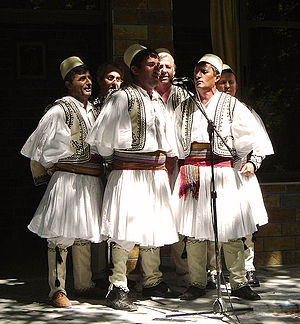Iso-Polyphony
Iso-Polyphony is a traditional part of Albanian folk music. It has been recognized by UNESCO as an Intangible Cultural Heritage since 2008.[1] Southern Albania, including the regions of Lalëria (Myzeqe), Toskeria, Chameria, and Labëria, practice this polyphonic singing. Some areas in North Macedonia, and southern Montenegro, also have a similar form of polyphonic singing.[2]
| Iso-Polyphony | |
|---|---|
 A traditional male group performing | |
| Country | Albania |
| Domains | Performing arts, Social practices, rituals and festive events. |
| Reference | 00155 |
| Region | Europe and North America |
| Inscription history | |
| Inscription | 2008 (3rd session) |
| List | Representative |
 | |
The region of Labëria in Albania is famous for multipart singing, with songs having two, three, or four parts. Three-part ones and are the most complex form of polyphonic singing. The Gjirokastër National Folklore Festival in Albania, held every five years in October since 1968, often features many polyphonic songs.[3]
History
The Albanian iso-polyphony and Balkan polyphonic music are believed to be ancient traditions dating back to the Thraco-Illyrian era, even though historical records are lacking.[4] Scholars believe these musical traditions, passed down orally through generations. Specific features like the pentatonic structure and a cappella singing, suggest an ancient origin. The music's development differs from medieval Byzantine music, which was institutionalized and composed by individuals. Balkan polyphonic music was formed collectively, transmitted orally, and performed by musically illiterate people. Despite living side by side with Byzantine music, their mutual influence is considered relatively small.[5][4]
Development
Albanian polyphonic traditional music started with two melodic lines: the taker (1st voice) and the turner (2nd voice). Over time, the turner's role became more defined. Two-voice iso-polyphony, with a clear turner role, is found in places like Gjirokastër and Dukat. This style is also present in various Albanian areas and among Arbëreshë in Calabria. The idea of two-voice polyphony is considered a "hidden" three-voice iso-polyphony.[5]
The next development was the drone (iso), forming three-voiced polyphony. The drone enriched the harmony between melodic lines and is now common in Albanian polyphonic tradition, mainly sung by men. Three-voice polyphony is typical in areas like Skrapar, Gramsh, Gjirokastër, and Vlorë.[5]
The launcher (3rd voice) evolved last, creating four-voiced polyphony. While absent in Toskëria, Myzeqeja, and Chamëria, four-voiced polyphony is only found in Labëria alongside the more common three-voiced style. Neço Muko's recordings in the 1920s-1930s played a role in consolidating the four-voice iso-polyphony.[2]
Pleqërishte (genre)
Pleqërishte is a genre of Albanian folk iso-polyphony sung by men in Labëria, especially in Gjirokastër. It is known for its slow tempo, low pitch, and small range.[6]
The name "Pleqërishte" means both "of old men" and "of the old time," referring to the singing style and lyrical themes of the songs. These songs are also called "lashtërishte" in Gjirokastër, emphasizing their ancient themes. While these topics have become less popular, they are still noteworthy thematically.[1]
Pleqërishte songs have a slow tempo, low pitch, and minimal vocal variation, distinguishing them from genres like "djemurishte" (of young men). In this four-part genre, the third soloist (hedhës) plays a crucial role. Unlike other genres, the hedhës in pleqërishte relieves the main soloist (marrës), giving them a break. The performance starts with the marrës singing the initial lines, followed by the introduction of the second soloist (kthyes) and then the hedhës. After the hedhës, the marrës's lyrics are repeated by the drone group in various forms.[6]
References
- ↑ 1.0 1.1 "UNESCO - Albanian folk iso-polyphony". ich.unesco.org. Retrieved 2024-02-02.
- ↑ 2.0 2.1 Ahmedaja, Ardian; Haid, Gerlinde; Spitzbart, Johannes (2008). European voices. Schriften zur Volksmusik. Wien: Böhlau. ISBN 978-3-205-78090-8.
- ↑ Ahmedaja, Ardian; Haid, Gerlinde (2008). European Voices: Multipart singing in the Balkans and the Mediterranean. I. Böhlau Verlag Wien. ISBN 978-3-205-78090-8.
- ↑ 4.0 4.1 Stipčević, Aleksandar (1989). Iliri: povijest, život, kultura (in hrvatski). Školska knjiga. ISBN 978-86-03-99106-2.
- ↑ 5.0 5.1 5.2 Shetuni, Spiro J. (2014-01-10). Albanian Traditional Music: An Introduction, with Sheet Music and Lyrics for 48 Songs. McFarland. ISBN 978-0-7864-8630-4.
- ↑ 6.0 6.1 Ahmedaja, Ardian; Haid, Gerlinde (2008). European Voices: Multipart singing in the Balkans and the Mediterranean. I. Böhlau Verlag Wien. ISBN 978-3-205-78090-8.